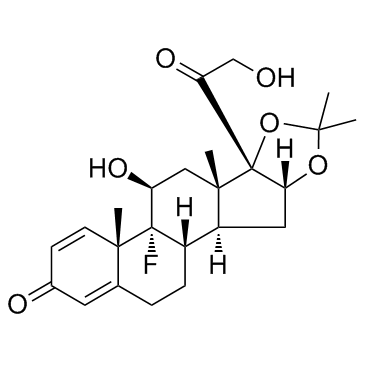Triamcinolone acetonide

Triamcinolone acetonide structure
|
Common Name | Triamcinolone acetonide | ||
|---|---|---|---|---|
| CAS Number | 76-25-5 | Molecular Weight | 434.498 | |
| Density | 1.3±0.1 g/cm3 | Boiling Point | 576.9±50.0 °C at 760 mmHg | |
| Molecular Formula | C24H31FO6 | Melting Point | 274-278ºC (dec.) | |
| MSDS | Chinese USA | Flash Point | 302.7±30.1 °C | |
| Symbol |

GHS08 |
Signal Word | Danger | |
|
Novel Nrf2 activators from microbial transformation products inhibit blood-retinal barrier permeability in rabbits.
Br. J. Pharmacol. 172(5) , 1237-49, (2015) Nuclear factor erythroid 2-related factor 2 (Nrf2) is a redox-sensitive transcription factor that binds to antioxidant response elements located in the promoter region of genes encoding many antioxidant enzymes and phase II detoxifying enzymes. Activation of ... |
|
|
Evaluation of the reporting level to detect triamcinolone acetonide misuse in sports.
J. Steroid Biochem. Mol. Biol. 145 , 94-102, (2015) Triamcinolone acetonide (TA) is prohibited in sport competitions using systemic administrations (e.g., intramuscular, IM), and it is allowed by other routes (e.g., intranasal, IN, or topical, TOP). A reporting level of 30 ng/mL is used to discriminate between... |
|
|
A general analytical platform and strategy in search for illegal drugs.
J. Pharm. Biomed. Anal. 100 , 215-29, (2014) An effective screening procedure to identify and quantify active pharmaceutical substances in suspected illegal medicinal products is described. The analytical platform, consisting of accurate mass determination with liquid chromatography time-of-flight mass ... |
|
|
Detection and characterization of triamcinolone acetonide metabolites in human urine by liquid chromatography/tandem mass spectrometry after intramuscular administration.
Rapid Commun. Mass Spectrom. 28(16) , 1829-39, (2015) Glucocorticosteroids are prohibited in sports when used by systemic administrations (e.g. intramuscular, IM), whereas they are allowed using other ways of administration. Strategies to discriminate between administrations routes have to be developed by doping... |
|
|
Verteporfin therapy and triamcinolone acetonide: convergent modes of action for treatment of neovascular age-related macular degeneration.
Eur. J. Ophthalmol. 16(6) , 824-34, (2006) Choroidal neovascularization associated with age-related macular degeneration is the primary cause of blindness in the elderly in developed countries, due to a number of pathogenic effects, including angiogenesis, cell-mediated inflammation, leukocyte adhesio... |
|
|
Intralesional triamcinolone acetonide injection in hypertrophic skin surrounding the percutaneous titanium implant of a bone-anchored hearing aid.
J. Laryngol. Otol. 122(12) , 1368-70, (2008) We present a patient with persistent hypertrophic skin surrounding the percutaneous implant of a bone-anchored hearing aid system, successfully treated with intralesional applied corticosteroids.Case report and review of the world literature concerning bone-a... |
|
|
Visual acuity and intraocular pressure after high-dose intravitreal triamcinolone acetonide in selected ocular diseases.
Eye (Lond.) 22(7) , 869-73, (2008) Within the last 5 years, intravitreal injections of triamcinolone acetonide have been for a wide variety of ocular diseases with intraocular oedema and neovascularization. With clinical experience accumulating, the question arises for which indication the sid... |
|
|
Pharmacokinetics of triamcinolone acetonide for the treatment of macular edema.
Expert Opin. Drug Metab. Toxicol. 7(10) , 1327-35, (2011) The use of intravitreal triamcinolone acetonide (TA) for the treatment of various types of macular edema has been widespread, particularly for the last decade. Currently, there is a scant amount of evidence-based literature evaluating the pharmacokinetic prof... |
|
|
[Triamcinolone acetonide in the treatment of corticosteroid-resistant asthma: risks and benefits].
Arch. Bronconeumol. 44(6) , 324-7, (2008) Few therapeutic alternatives to prednisone are available for severe, corticosteroid-resistant asthma. Injectable triamcinolone acetonide (TA) has been used in this type of asthma, although its use is controversial. TA shows considerable efficacy when compared... |
|
|
The influence of peri-incisional triamcinolone acetonide injection on wound edge apposition.
J. Dermatolog. Treat. 25(4) , 345-9, (2014) Local administration of corticosteroids has been demonstrated to have both beneficial and detrimental effects on wound healing. The advantages of limiting localized edema must be weighed against corticosteroids' disadvantageous inhibition of the normal growth... |